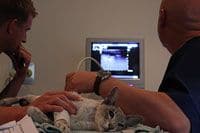Pets Bitten By Snakes
Perth pets regularly come into contact with snakes
Australia is home to many snakes, both venomous (poisonous) and non-venomous. In Western Australia the most commonly seen snake bites in pets are due to Brown Snakes (Dugites), Tiger Snakes, and less commonly the black snakes (King Brown or Mulga snake), Death Adders and Taipans. The venom from their bite contains toxins which are responsible for the life threatening changes associated with envenomation.
Perth pets regularly come into contact with snakes, as they exist throughout urban areas, near wetlands and also in more arid regions. The natural curiosity of our pets and their natural hunting instincts (particularly cats), ensure that they are keen to investigate these slithering reptiles.
Symptoms of a snake bite

Animals that collapse and then apparently recover will slowly develop symptoms over the next 30-60min
Vomiting
Drooling and trembling
Dilated pupils
Involuntary urination or defecation
Rapid breathing and or panting
Bleeding from bite wounds or other body sites (bloody diarrhoea)
Collapse (often immediate which is followed by a period of recovery)
Red or brown discolouration of urine
Paralysis (starting with the hind limbs and progressing towards the head)
Death from respiratory failure (paralysis of breathing muscles)
In the majority of cases the bite site is not found, and there is very little notable pain or swelling associated with Australian snake bites.
If you suspect your pet has been bitten by a snake, if you have seen a snake near your pet, or if you pet is acting strangely after being in an area where snakes are likely to be found (particularly in the warmer weather), seek veterinary attention immediately. Delays in treatment can be fatal.
Emergency Treatment before Transport to the Vet
- If your pet is not breathing, attempt mouth to nose resuscitation, giving one breath every 3-6 seconds.
- Do not risk envenomation by attempting to bring a live or dead snake in to assist identification– a test can be performed on your pet to identify the type of antivenin required.
- Keep your pet as still as possible to minimise venom absorption. If a limb has been bitten, bandage the entire leg firmly. This limits venom movement through the lymphatics. Do not try to cut off the circulation with a tourniquet
What to Expect at the Vet
Blood and urine testing to assess the severity of the envenomation, and identify the type of snake if required.
Oxygen therapy to help with breathing.
Intravenous fluid therapy to support blood pressure and kidneys.
Intravenous medications and antivenin if required – some animals need multiple doses and antivenin can be quite expensive.
Assisted ventilation – a machine breathes for your pet until it can breathe on their own.
Assisted feeding – with special feeding tubes to provide nutrition if the food pipe muscles are affected.
If your pet requires treatment, this usually involves hospitalisation for at least 12 – 24 hours, and in some cases, several days. When your pet is discharged home, your vet will recommend confined rest for 1 – 2 weeks.
In some patients, no treatment is required, due to a lack of clinical and laboratory evidence that the patient has been envenomated. In these cases, monitoring your pet for any delayed symptom of envenomation at a veterinary hospital for a period for 12 – 24 hours may be all that is required.
With appropriate and timely medical therapy, many patients recover completely. Unfortunately, if necessary treatment is not instigated, many of these patients will not survive.



